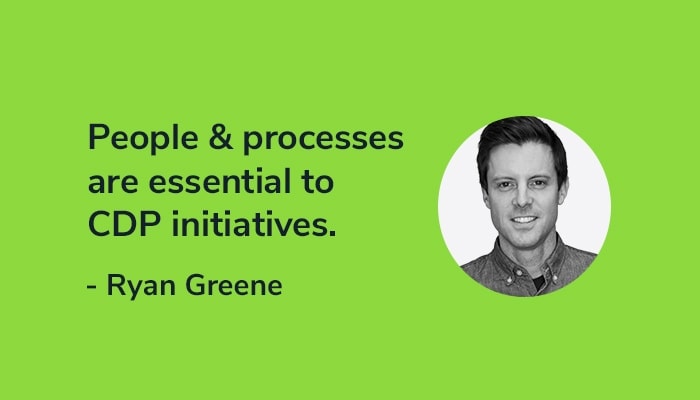Planning for CDP Change Management: A Proven Approach

Early Lesson On Change
In the early days of ActionIQ, and only a few months into my tenure, we were in deep conversations with a prospective client about how our technology could transform their personalization initiatives. The prospect had just brought in a new, innovative CMO to drive this transformation across the company. In the first week in his new role, his CRM team presented him with a multimillion dollar Salesforce Marketing Cloud contract. They assured him the technology was all vetted and teed up, and was the most logical choice for the company’s needs. The CMO declined to sign the contract. He wasn’t going to allow his business strategy be dictated by a tool, and he knew that he needed to align his organization’s priorities prior to diving head-first into a multi-year technology commitment.
ActionIQ entered the picture a few months later, after the CMO had the opportunity to get a handle on the current state of his organization. As someone with a deep analytics background, he understood how both ActionIQ’s approach to the problem and our technical solution was unique. He was totally bought in to our team and technology, but he was less confident that his organization would be able to adopt it and be successful. “So before we can get there,” he said, “I have to solve a different problem: my teams are used to operating in silos, and I’m not confident they will be able to change their processes to successfully adopt a new technology and operating model.”
I suddenly realized that just delivering a better product was not enough. To make our clients successful, we would have to think bigger. We’d have to help them plan for and manage the organizational change required to implement and scale an entirely new solution—a customer data platform.
Focus on People and Process
…many of the teams were meeting each other for the first time in our discovery meetings.
The CMO asked us to help map and align his siloed marketing and customer service teams. And being the scrappy startup we were at the time, we jumped right in! We embedded ourselves at the prospect, and over the course of 2 weeks, we interviewed leaders, do-ers, and other stakeholders across multiple teams. We found they were each using their own tools to deploy different messages across different channels, at different parts of the customer lifecycle—and nobody across teams was talking to each other. In fact, many of the teams were meeting each other for the first time in our discovery meetings.
After the initial discovery work, we came back with a holistic organizational action plan. The plan documented use cases and success metrics, and detailed changes to people, process, and technology the company needed to implement. To complement it, we also laid down a long-term vision including how we’d connect teams who’d never talked before, and how the company could design new incentives and ways of working. We realized that this work—whether it was led by us or someone else—was essential to our clients’ success with their CDP initiatives. This was the genesis of ActionIQ’s Value Mapping practice—which is the subject of this piece.
Change Management Fundamentals
Since that client engagement of years ago, ActionIQ has worked with dozens of the world’s largest and most sophisticated companies across many industries. In close partnership with brands like Saks Fifth Ave, Michael Kors, The New York Times, Pandora, Verizon and more, we’ve uncovered the core foundational elements of change management for a CDP—separating what is differentiating vs. distracting.
Three key components come to the fore:
- Executive sponsorship. The foundation of your initiative begins with identifying the core goals and use cases that will make a difference for your organization, and getting executive-level alignment, sponsorship, and commitment around them.
- Cross-functional alignment. You must methodically identify all stakeholders, across all relevant functions, and get input from all of them. A CDP marketing project is often the first time these groups have gotten together to talk about data-driven customer experiences—so there’s a lot to cover!
- Governance and accountability. You must document your plan with clear jobs to be done, ownership, accountability, ongoing project governance and reporting structures—this task force will drive transformation over the long haul.
Focusing on these three tenets of change management at the outset of your CDP initiative, or at the outset of any digital transformation effort, will set you up for success.
(For deeper detail on core change management requirements, download our Change Management Best Practices eBook now).
ActionIQ’s Value Mapping Practice
Change management best practices are great in theory, but mapping them to your organizational idiosyncrasies can seem daunting. There are so many dimensions to consider:
Where do you start?
Who should you involve?
What should be the scope of your requirements gathering?
How will you prioritize use cases?
What should be included in your business case?
How to map out short-term wins that lead to the long-term goal?
With research, consultation and time, you can eventually work your way through these challenges. But it is possible to get off the ground faster, with less risk, and without going it alone.
We’ve taken the lessons and best practices we compiled over years of CDP change management experience into a custom services offering—we call it Value Mapping. During an ActionIQ Value Mapping exercise, our team partners with your organization to deliver a documented action plan covering your CDP initiatives:
- Business vision and priorities
- Current state and constraints
- Future state and solution blueprint
- Prioritized use case roadmap
Value Mapping helps you get your CDP initiative set on a strong foundation—addressing all the challenges described in the table above, and ensuring the three core requirements for CDP change management are in place at the outset of your transformation.
Trusted Experts
We developed the Value Mapping practice due to overwhelming demand from our customers for assistance with CDP-related change management. We’ve outlined the Value Mapping process above, but the people who work with you to execute it are just as important. To help plan a successful digital transformation, you should only trust in people with:
- Deep experience as a marketing, analytics and data practitioner
- A track record of implementing organizational change
- A clear understanding of risks and how to mitigate them
- Dedicated project management resources and proven success
- Experience planning delivery, training and ongoing support
ActionIQ’s value mapping teams are made up of martech, analytics and business experts with decades of experience as leaders and practitioners. The practice is led by Tamara Gruzbarg, an industry-recognized data and analytics leader who previously held pivotal digital transformation roles at Citi, Experian, Stuart Weitzman and Meredith Corporation. In short, in this fast moving, and confusing CDP market, you cannot be in better hands than the ActionIQ team when it comes to helping plan your CDP initiative.
That said—your digital transformation is bigger than your CDP initiative. The Value Mapping practice and our team should not be a substitute for your larger strategic plan. At its core, change comes from within, and your org and culture need to embody it. Many of our clients partner with outside consultants to help facilitate the larger aspects of digital transformation—ActionIQ’s Value Mapping practice is designed to complement those efforts by outlining a detailed plan around the CDP-related aspects of it.
Results-Driven Approach
Bringing it back to our first Value Mapping exercise with a client from more than four years ago: six previously siloed teams were able to come together to coordinate use cases across the organization and align around a common set of goals. After a short but intense burst of transformative work, the company achieved:
-
50% reduction in martech and analytics vendors (went from 5 ESPs to 1)
-
80% reduction in time to market for campaigns (went from 3 weeks to 3 days)
-
Connected journeys across the entire customer lifecycle (connected acquisition, CRM, retention, and servicing)
-
20% increase in YoY paid customer subscriptions
For me, and ActionIQ, it was proof that technology alone won’t get you there. To achieve success, you need a trusted partner along for the ride.





